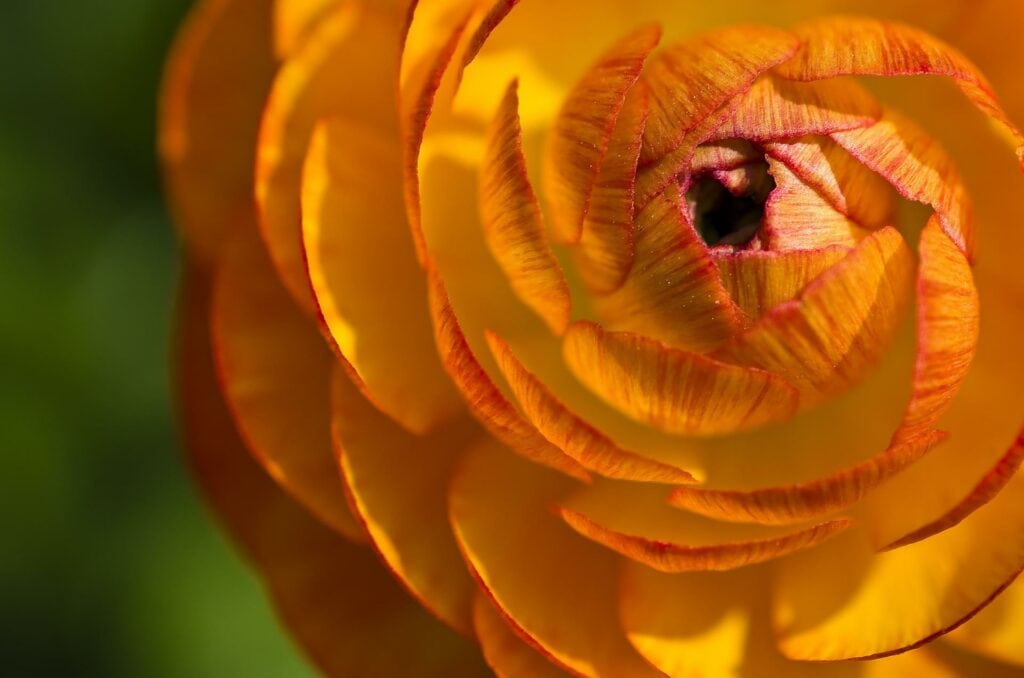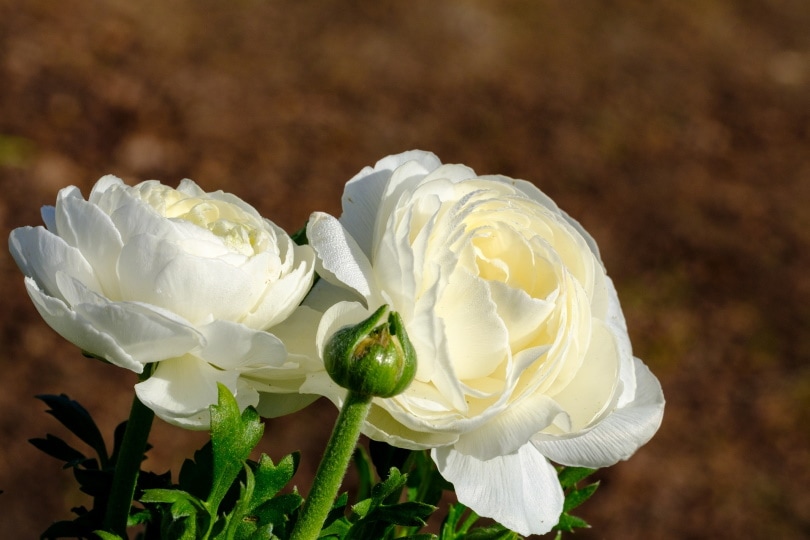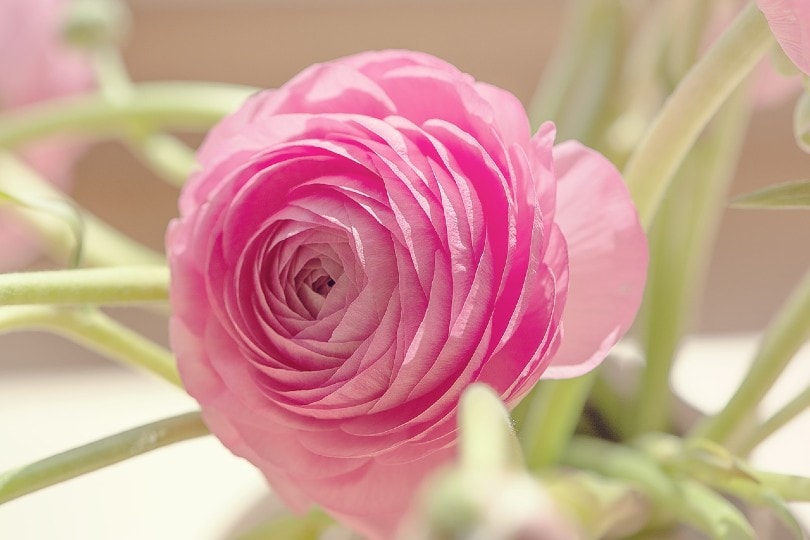How & When to Plant Ranunculus: Tips, Factors, & FAQ
-
Pete Ortiz
- Last updated:

If you live in the Midwest or even up north and are looking for cool-season plants, ranunculus will be a perfect pick. They thrive in spring temperatures (55–65°F) and require little maintenance. Second, while they do prefer full sun, you can grow them in partial shade as well. And third, these flowers are gorgeous and will stand out in any environment. How do you plant them, though?
What’s the right time for planting ranunculus? Should the soil be soggy or well-drained? And what about watering and the blooming period? These are just some of the questions we will cover in this guide. So, if we got you all excited about ranunculus, join us, and let’s learn how to grow it!
Ranunculus: A Low-Maintenance Flower

As an invasive, prolific plant, ranunculus needs very little maintenance. Thanks to the long, spider-like roots, it can survive for a long time without water, nutrients, and sunlight. On top of that, this flower is known for its rampant nature: it will cover your entire garden with beautiful, multicolored petals in the blink of an eye! But still, when should you plant it? What’s the best time for that?
| Botanical Name | Ranunculus |
| Soil Type | Well-drained, sandy, rich, moist (not soggy) |
| Soil PH | 6.0 – 6.5 (slightly acidic) |
| Sun Exposure | Full sun/partial shade |
| Watering Requirements | Moderate, deep watering |
| Temperature | 55 – 90° Fahrenheit |
| Hardiness Zone | 3 – 10 USDA |
| Days to bloom | 3 – 4 months from planting |
The 8 Tips on How & When to Plant Ranunculus
1. Spring vs Summer: What’s the Perfect Planting Time?
To get the right answer to that, you need to check the hardiness zone of the area that you live in. There’s nothing hard about this part: the lower the hardiness zone, the colder the weather. Ranunculus plants are hardy to zones 3–10 (mostly 8–10) and thrive in long springs and relatively mild winters. So, once you figure out your zone, the next step would be to pick a species that grows best in it.
The right time for planting ranunculus is late fall or early winter. On average, it takes the sprouts 80–90 days to appear; a month later, you’ll start seeing the buds, and the lovely flowers will follow shortly. But what if you live in a colder area (zones 3–8)? Then plant the corms in mid/late spring (as soon as the final frost passes). In that case, the plants will bloom in late summer.
2. Full Exposure or Partial Shade?
Ranunculus is one of those rough-tough flowers that don’t require 8–10 hours of sunlight to grow. Yes, it does prefer full exposure to the sun for 6–8 hours, but it also grows in partial shade. So, if you have a spot in your garden that doesn’t get much sun, you can plant a ranunculus there. It might take a bit longer to flower, that’s true, but you’ll still see the plant flourish.
3. Taking Care of the Corms

If it’s a bit cold outside for planting ranunculus, the best thing to do is to store the corms. First, get rid of all the dirt. Second, put them in a box somewhere in a dry, shady, and cool spot (colder than 50°F). And right before planting the corms, let them bask in a bucket full of water for 3–4 hours to stimulate steady growth. Covering them with moist soil will also work. Do you see tiny white roots?
Are the corms getting almost twice as big? Then it’s time for planting! Don’t keep them in the water for too long to avoid root rot. Also, while ranunculus does love sunlight, it doesn’t grow that well in tropical weather: the ideal temperature for it is 55–75°F. And remember: the bigger the corms/bulbs, the bigger and healthier the blooms will be. Plant them facing down.
4. Soil Structure and pH
As for the soil, it needs to be well-drained yet slightly moist. And when it’s sandy and organically rich, that will help the plants grow faster. Also, make sure the soil is neutral or slightly acidic (6.0–7.0). Plant the corms 2–3 inches deep and see that there’s at least a 5–6-inch gap between them. And what about fertilizing? Should you do that? Yes, adding liquid fertilizer 1–2 times a month will make ranunculus bigger and help it last longer.
5. Mulching for Moisture Retention
The pro of using mulch is that it will conserve moisture. This way, you won’t have to water the plants every single day, and they’ll still get enough water to prosper. On top of that, mulch is great at keeping the soil warm when it’s cold outside and cooling it down a bit during hot summer days. As a bonus, it will keep most pests at bay.
6. Adequate Watering is Key

Speaking of watering, it should be moderate yet deep. Water the corms generously and wait until the sprouts appear (in 2-3 weeks) to water them again. Let the plants dry before each “session”. And don’t water the plants during fall. Give the corms time to dry. To save them for next year, dig every single corm out and stores them in a cool area.
7. Blooming Time
These flowers are relatively fast to grow and mature. As mentioned, it takes them 3–4 months to bloom after planting. And, if you take proper care of the plants, the flowers will come back next year. They can be deciduous, evergreen, and even annual, but for the most part, ranunculus plants are perennials. That means they last for years and don’t die after the first season. But how long do the flowers “stick around”?
Don’t worry; they won’t disappear overnight. Most varieties keep blooming for 1–2 months. And if you cut the buds and put the plants in a vase, they will live for 1–2 weeks. Cut them while they’re soft to maximize the vase life. Be very gentle not to damage the stems or the flowers. And don’t forget to remove the dead flowers. This will maximize growth and keep the plants healthy.
8. Buttercups vs. Spearworts: What’s the Difference?
Ranunculus is a pretty large genus of flowering plants. Overall, there are 600 different types of ranunculus flowers growing on planet Earth, famous for their multilayered, bowl-shaped, and brightly colored petals. So, does that mean buttercups, crowfoots, and spearworts are different species? Yes, that’s true, but they belong to the same family. These names are used to describe the most popular varieties.
In many ways, they are similar to each other, but they’re still quite different. The colors, stems, and flowers are what set the various ranunculus species apart. Now, the Persian buttercup is the most popular ornamental ranunculus flower out there. It’s so commonly used that you’ll hear people just call it ranunculus.
FAQ
Are There Any Aquatic Varieties?
One of the most interesting facts about ranunculus is that it can be both aquatic and terrestrial. That’s right: while most species thrive in soil, certain plants like the white water-crowfoot flourish in water. It always grows in dense patches and has stems that reach up to 24 inches. Ranunculus aquatilis usually bloom in April, but it’s not rare for it to come to life as late as August.
Cold temperatures are known to delay flowering, but this plant is quite tough and winter-hardy. The water-crowfoot grows on shallow water and prefers full sun. You won’t have to water it, of course, as it will get it from the pond. So, if you have a small lake, stream, or pond in the yard, it will be a great idea to try and grow this ranunculus flower there. It’s native to North America, by the way, and won’t be a challenge to cultivate.

Are Ranunculus Flowers Dangerous?
The short answer is they are dangerous; ranunculus plants are toxic when eaten fresh. They are also harmful to pets (cats, dogs, and rabbits) and livestock. The side effects for domesticated animals can be quite severe, including excessive salivation, blistering, and even bloody diarrhea. For us (humans), skin irritation and burns are the most common symptoms. So, don’t forget to put protective gloves on before touching them.
Moreover, if you take ranunculus by mouth, that will cause vomiting, abdominal pain, headaches, and even loss of consciousness. With that said, in Asian medicine, ranunculus is used to treat skin diseases, flu, meningitis, and arthritis, even though there is no scientific proof of any benefits. When ranunculus flowers are dried, some of the toxins fade away. But, again, this isn’t backed by any medical or scientific research.
Ranunculus: Weeds or Not?
Resilient, fast-to-grow, and invasive, buttercups and spearworts are, indeed, considered by many gardeners to be a weed. They are quite hard to keep at bay, especially if you don’t use any harsh herbicide products. At the same time, the marvelous flowers make them a welcome addition to any garden. Be careful not to let ranunculus take over your entire yard, though!
Conclusion
Ranunculus is tough, can survive in cold weather, and doesn’t take forever to bloom. It is also quite flexible and can be planted in spring or fall. On top of that, this flower requires almost no maintenance and doesn’t need to be moved indoors. That makes it a perfect choice if you want to introduce something new and exciting into your backyard garden.
Water it adequately, make sure the soil is rich, well-drained, and sandy, and protect the corms with mulch. If you do that, ranunculus will grow rapidly and cover the surface with ruffled petals, intriguing colors, and a lovely scent. And the best part is that bit will come back next year!
- Buttercup – Uses, Side Effects, and More
- Org – Ranunculus aquatilis
- How to Plant & Grow Water Buttercup
- Breck’s – HOW TO GROW RANUNCULUS
- CABI – Ranunculus bulbosus
- Candide – BUTTERCUPS OVERVIEW
- Com – Aquatic & Terrestrial Plants
- Edu – Bulbous Buttercup – Weed of the Week
- Ranunculus Care Guide: How to Grow Ranunculus
- HOW to PLANT and GROW RANUNCULUS
- USDA Plant Hardiness Zone Map
- Edu – Bulbs, Corms, Rhizomes and Tubers
- Your Guide to Planning, Planting, and Growing Ranunculus
Featured Image Credit: Pixabay
Contents



